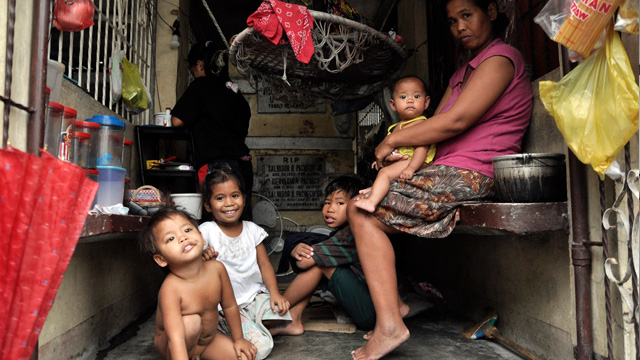SUMMARY
This is AI generated summarization, which may have errors. For context, always refer to the full article.

MANILA, Philippines – When tropical storm Quinta hit Eastern Samar, rescuers had trouble retrieving the bodies of a mother, father and son who died in the remote barangay of Del Pilar. They had to cross a swollen river before they could reach the nearest road that was passable by ambulance. When they found one of the family’s surviving children, a 12 year-old with broken legs, it took 5 hours to transport the minor to Eastern Samar Provincial Hospital in Borongan City.
Some of the biggest roadblocks to health care in remote areas of the Philippines are the roads themselves, explained a Department of Health (DOH) official at a February 6 press conference on maternal health.
Inadequate infrastructure is particularly detrimental for pregnant women. “They can’t reach the hospital alive because they are geographically remote and distant,” said Health Undersecretary Teodoro Herbosa.
“Hemorrhage is the most common cause of death (during childbirth). What do you do to solve that,” asked Herbosa, a former trauma surgeon who spent his life saving people from bleeding out. The irony is not lost on him. “That is my specialty. I understand very well how to treat people from hemorrhage. But there is a system problem,” he said.
“The solution might not be building all these birthing centers. The solution is really to build roads,” he said.
Bad roads, high mortality rates
Data collated by the DOH and the Zuellig Family Foundation and presented at the press conference showed high maternal mortality rate in geographically isolated and disadvantaged areas (GIDA) in the country.
For example, the maternal mortality rate in GIDA municipalities in Samar rose from 377 deaths per 100,000 live births in 2009 to 392 deaths in 2010. That’s higher than the latest national average of 221 deaths per 100,000 births, reported in 2012 by the DOH.
Herbosa pointed out that access to health services is generally better in urban areas, where infrastructure is better.
Though many don’t realize the connection between roads and maternal death, economists have stressed for years that underinvestment in roads is holding the country back.
Only 14% of local roads are paved, compared to 69% of national roads, according to Gilberto Llanto, former National Economic and Development Authority (NEDA) Deputy Director who wrote the discussion paper “Investing in Local Roads for Economic Growth.”
“Local roads are generally of poor quality and condition…. This is indicative of the inability of local government units to maintain local roads, which hampers local growth and development,” he told Rappler earlier.
Amid a growing backlog in government infrastructure projects, the maternal death rate remains high.
Herbosa said it is unlikely the country will meet its Millennium Development Goal to have 52 deaths per 100,000 live births by 2015.
The most recent statistics from the DOH show that the maternal death rate actually increased from 162 per 100,000 live births as reported in 2006 to 221 per 100,000 as reported in 2011 by the Family Health Survey.
A dire situation in Samar
The lack of adequate health services and access to available services have become serious problems in many of the Philippines’ poorest regions. Herbosa described the maternal health situation in the mountainous Cordillera, the conflict-rife Autonomous Region in Muslim Mindanao, and the island province of Samar, as “dire.”
“We have health centers with no doctor, no nurses. We have centers that cannot provide basic services like immunization, and family planning,” explained Dr Jan Krisna Rodriguez, who worked in Samar for 2 years.
So it may not just be a lack of roads but services. Herbosa said that services were so inadequate in Samar that internally Filipinos there would migrate to neighboring Leyte to seek medical treatment.
“That is a symptom of the fact that the local health system in Samar is not good enough. Because if people will leave the island to actually get health care from another province then the local government of the Samar provinces are not delivering the services they are supposed to deliver,” he said.
Partial solution in the works
At least in Samar, the DOH is working on a partial solution.
Over 3 years the DOH, global pharmaceutical company MSD and Zuellig Family Foundation plan to pour a little over P50-M into a program that will help reduce maternal mortality in 21 isolated local government units in Samar. Of those funds, P20.2-M will come from MSD, P18.2-M from Zuellig and the rest from the DOH and municipal governments, according to MSD External Affairs’ Market Access Manager Michael Alzona.
However the program isn’t directed at buying new health material but on educating mayors, community leaders, and local health officials to make the best decisions for those they serve. That puts most of the responsibility on local officials under whose watch the health situation has persisted at these extremes.
Herbosa said the DOH is considering scaling the project up to the national level including Mindanao. “Right after the elections, when the new local leaders are elected, we expect to target new local sites,” he said.
For now, we will have to wait and see where the road leads. – Rappler.com
Add a comment
How does this make you feel?
There are no comments yet. Add your comment to start the conversation.